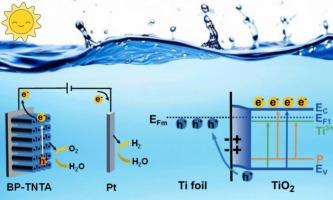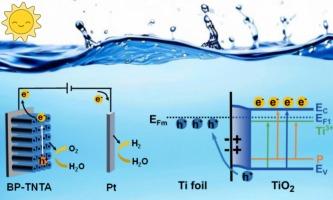黑磷:一种很有前途的非金属掺杂源,用于增强TiO2纳米管阵列光阳极的可见光光电催化水分解性能
IF 6.9
2区 材料科学
Q2 CHEMISTRY, PHYSICAL
引用次数: 0
摘要
在tio2基光电催化剂中掺杂非金属磷是提高其性能的一种很有前途的策略,但它面临着与高掺杂水平、稳定性和产氢耐久性相关的挑战。为了解决这些问题,我们开发了一种在密闭空间内高压低温条件下一步合成黑磷掺杂TiO2纳米管阵列(BP-TNTA)的新方法。该方法在600℃下成功制备了磷含量可调、结晶度高的BP-TNTA。所得BP-TNTA具有优异的光电催化性能,在模拟阳光下光电流密度(46.3 μA cm−2)比未掺杂的TNTA (10.5 μA cm−2)提高了4.4倍。可见光活性的增强是由于bp掺杂和Ti3+态引入了多个杂质能级,从而缩小了带隙,延长了可见光响应。此外,BP-TNTA与Ti衬底之间的肖特基结提高了光生载流子的分离和传输效率。该研究为开发强大的p - tio2基光阳极材料提供了有价值的见解。本文章由计算机程序翻译,如有差异,请以英文原文为准。


Black phosphorus: A promising nonmetallic doping source for enhancing visible light photoelectrocatalytic water splitting performance of TiO2 nanotube array-based photoanodes
The doping of non-metallic phosphorus into TiO2-based photoelectrocatalysts is a promising strategy to improve their performance, yet it encounters challenges related to high doping levels, stability, and hydrogen production durability. To address these issues, a novel one-step method was developed to synthesize black phosphorus-doped TiO2 nanotube arrays (BP-TNTA) under high-pressure and low-temperature conditions within a confined space. The method successfully produced BP-TNTA with tunable phosphorus content and high crystallinity at 600℃. The resulting BP-TNTA exhibited superior photoelectrocatalytic performance, with a 4.4-fold increase in photocurrent density (46.3 μA cm−2) under simulated sunlight compared to undoped TNTA (10.5 μA cm−2). The enhanced visible light activity is attributed to the introduction of multiple impurity energy levels by BP-doping and Ti3+ states, which narrows the band gap and extends the visible light response. Additionally, the Schottky junction between BP-TNTA and the Ti substrate improves the separation and transmission efficiency of photogenerated carriers. This study offers valuable insights for the advancement of robust P-TiO2-based photoanode materials.
求助全文
通过发布文献求助,成功后即可免费获取论文全文。
去求助
来源期刊

Applied Surface Science
工程技术-材料科学:膜
CiteScore
12.50
自引率
7.50%
发文量
3393
审稿时长
67 days
期刊介绍:
Applied Surface Science covers topics contributing to a better understanding of surfaces, interfaces, nanostructures and their applications. The journal is concerned with scientific research on the atomic and molecular level of material properties determined with specific surface analytical techniques and/or computational methods, as well as the processing of such structures.
 求助内容:
求助内容: 应助结果提醒方式:
应助结果提醒方式:


